Welcome to the
Brian Greig Orrery Page
What is an Orrery?
An Orrery is a planetary model of our Solar System. Typically an Orrery shows the first 6 planets circling the sun. Starting closest to the sun, these are: Mercury, Venus, Earth, Mars, Jupiter and Saturn. Sometimes some of the moons of a planet are also shown.

In this kind of planetarium, the sizes of the heavenly bodies and the distances between them are not to scale. This is because the true dimensions in the Solar System do not lend themselves to a linear down-scaling...
For instance, if we make the diameter of the smallest and innermost planet - Mercury, 1mm across, then the sun would need to be 30cm across, the distance from the sun to Mercury 1.2m, and the distance from the sun to Saturn 29 metres!! Not only would this be very difficult to engineer, it would also be very difficult to look at.
Hence the Orrery does not scale size and distance. However in a geared Orrery, the periods of revolution of the planets can be and are represented to scale. The clock-work Orrery shows how all the planets revolve counter-clockwise about the sun, and how the inner planets revolve more often than the outer planets.
In fact, a good Orrery demonstrates that for every revolution of Earth (1 Earth year), there are 4 revolutions of Mercury. You should also see that 1 year on Saturn takes 30 years on Earth!!! This effect is not only due to the greater distances the outer planets travel, but also because the inner planets move faster than the outer planets.
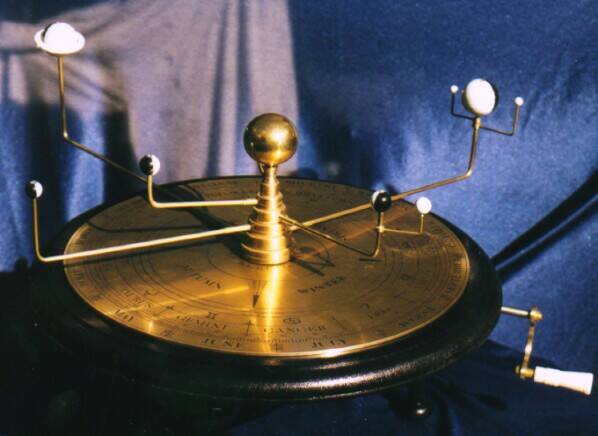
Most orreries show the planets travelling in perfectly circular orbits all in the same plane, when in fact the planets travel in elliptical or oval orbits, in slightly different planes. Some orreries of the past have attempted to mimic elliptical planetary orbits, by making the planets perform small localised clockwise revolutions as they revolve anti-clockwise around the sun!!!
With the possible exception of Earth's moon, moons are not usually geared. Sometimes the Earth moon is turned via a pulley.
The words planet (and plane) come from the greek word for wanderer, as these heavenly bodies move against the static backdrop of stars.
The Orrery is named after the Irish 4th Earl of Orrery, Charles Boyle (1676-1731), who in 1712 commissioned an artisan to copy an earlier Sun/Earth/Moon model by 2 clockmakers. Before long orreries developed planets and became excellent portable demonstrations of the Copernican heliocentric model of the solar system (sun at centre). Before this time, planetary models could only be found incorporated in large European town-clocks.
How does Brian create an Orrery?
An Orrery can take Brian anywhere from 6 weeks to 6 months to make. Although Brian has now made more than a dozen of these clockwork models, the process still requires great patience and precision.
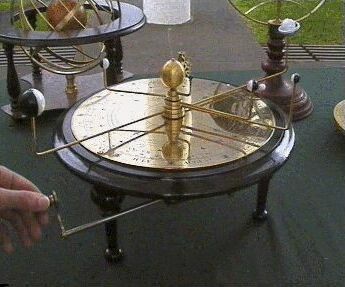
Potential customers are invited to see photos of Brian's orreries. The customer may request certain features to be added to previously created designs. They may request additional planets or revolving moons etc. Brian then spends a few weeks considering the implications of the new design requirements before he puts together a quote. The quote includes time estimates for design, new tool sourcing, construction and components.
The Orreries require gears to be hand-cut from various diameters of brass. I often help Brian with the mathematics for a new model. We need to calculate the required number of teeth on interlocking gears, so that the relative speeds of revolution are correct.
What did Brian make for Sydney Observatory?
Brian made 2 astronomical models for the Sydney Observatory. These were designed to be powered and operated around the clock by visitors of all ages. In order to stand up to this heavy workload, the gears had to be made especially thick.
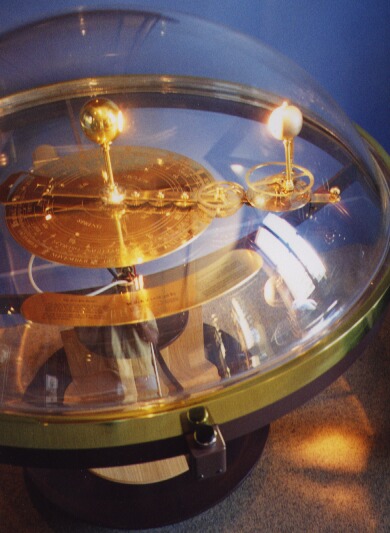
The first model was a hybrid Tellurian / Lunarium - an elaborate Sun/Earth/Moon system. It is a Tellurion (sometimes also spelt Tellurium) because it shows the Earth rotating anti-clockwise on its axis as it revolves anti-clockwise around the sun.
The sun includes a lamp which lights up the side of the Earth facing the sun, thus demonstrating day and night and how the sun rises in the east and sets in the west. The apparent motion of the stars can also be understood via the rotation and revolution of the Earth.

The north and south poles of the Earth are on a constant tilt as the Earth revolves around the sun, demonstrating the position of the north and south celestial poles, the significance of the zodiac and the occurence of seasons.
The model is also a Lunarium because it shows the moon revolving anti-clockwise around the Earth. This coupled with the light from the sun shows the phases of the moon - full moon (as viewed from Earth) when the Earth is between the sun and the moon, and new moon when the moon is between the sun and the Earth.
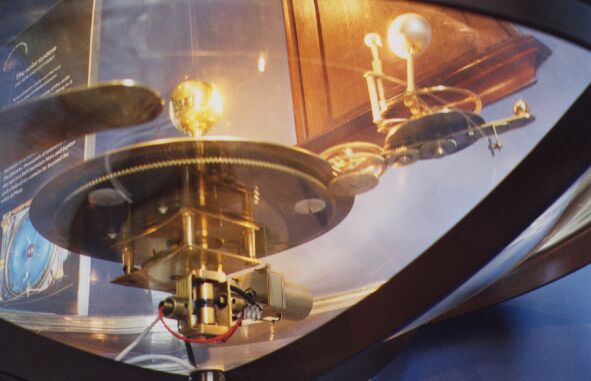
The moon's orbit is on a tilt, which explains why we do not get a lunar and solar eclipse every full moon and new moon respectively, but only when a full or new moon occurs as the moon is crossing one of the nodes - the points halfway up or halfway down the tilting orbit.
The angle of the tilt can be adjusted manually every year by the exhibitors to correct for the clockwise recession of the nodes.
The second model was a standard Brian Greig Orrery featuring all of the planets out to Saturn with no gearing for the moons. Brian made some improvements in design, to help it withstand the stresses of constant use.
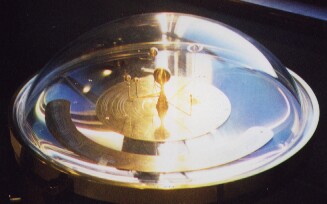
What is the Rettig Orrery?
The 'Rettig' was the first Orrery made in Australia which geared all 9 planets! This model demonstrated that 1 revolution of Pluto is completed after 1000 revolutions of Mercury!! Even Copernicus, Kepler and Newton would have been astonished!!!
In 1998, the non-geared prototype for the Rettig Orrery was used in a 26-part, Australian, science fiction, children's television series called 'Thunderstone'. The Orrery was chosen for use as the centre-piece in a young time-traveller's laboratory.
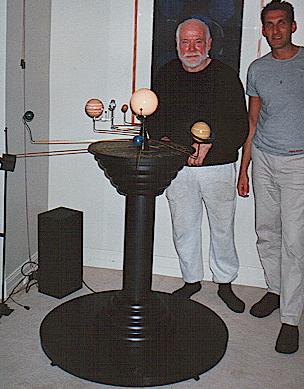
Mr Rettig, a Melbourne customer wanted something motorised and modern. The main body is black, the plate features Leonardo Da Vinci's famous image of man, and the planets are painted in their true colours as per Voyager photographs!
What moons should a 9-planet Orrery show?
A 9-planet orrery should at least show all bodies in the solar system that are bigger than the smallest planet Pluto. This would include Earth's moon (The Moon), 4 Jupiter moons (Io, Europa, Ganymede, Callisto), 1 Saturn moon (Titan), and 1 Neptune moon (Triton).
The most number of moons that the 9-planet orrery should show would be all moons larger than the largest minor planet, the asteroid Ceres, as a proper inclusion of Ceres would require its own gearing.
In this case, there would be Earth's moon (The Moon), 4 Jupiter moons (Io, Europa, Ganymede, Callisto), 5 Saturn moons (Tethys, Dione, Rhea, Titan, Iapetus), 4 Uranus moons (Ariel, Umbriel, Titania, Oberon), 1 Neptune moon (Triton), and the Pluto moon (Charon).
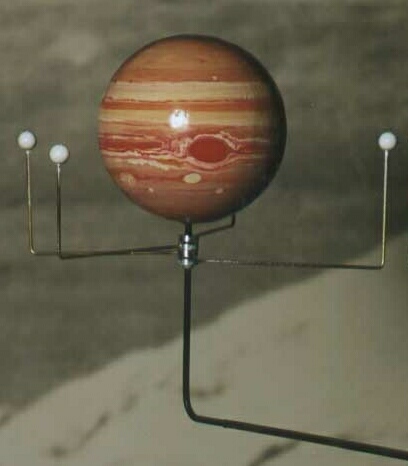
Recall that with the possible exception of Earth's moon, these moons would not be geared.
What is the Baltimore Orrery?
In late 1998, Maryland Science Center commissioned Brian to create a 9-planet orrery for their own series of exhibits.Now installed, this orrery is destined to become a favourite exhibit throughout the new millenium.
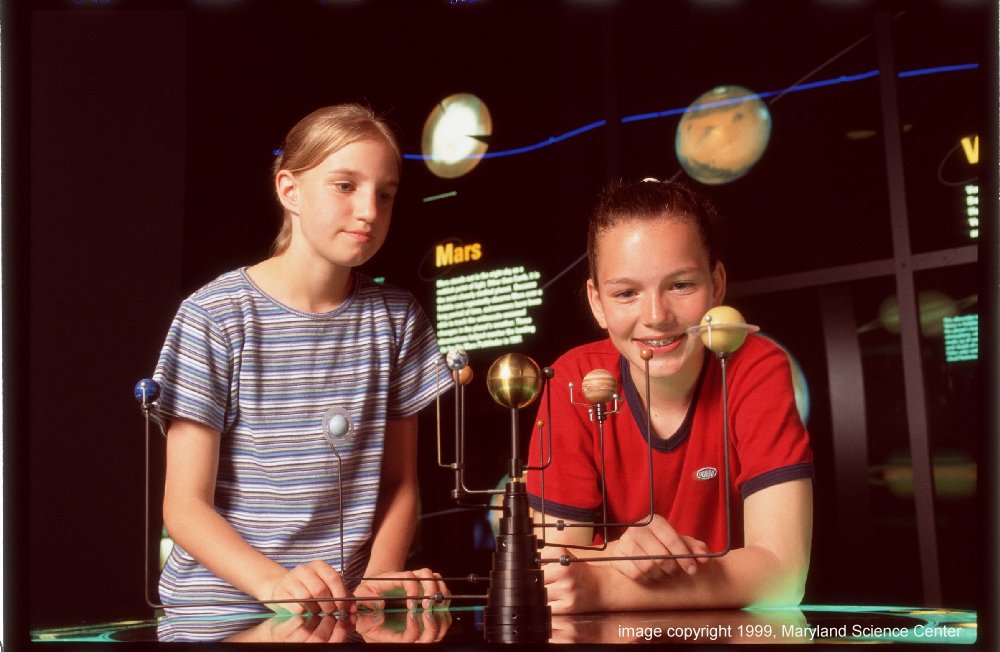
More Information?
To find out more about Brian and to see some of the other works he has created, visit the Brian Greig Page.
If you seek specific information about these Orrerys, please contact Brian directly using:
Post: PO BOX 207
Surrey Hills
Victoria
Australia 3127
Email: bgreig@telstra.easymail.com.au
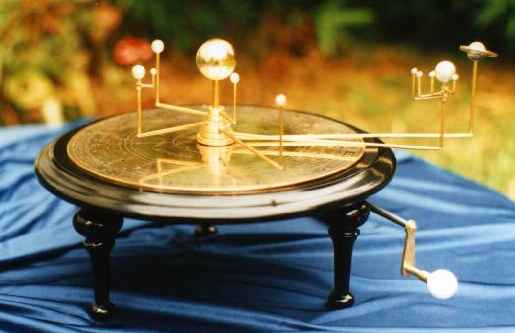
You are visitor number:
since April 3rd 1998
Last updated 16th April 2002.
Original Text Copyright © 1998-2002 Richard Lynton.
Original Artwork and Images Copyright © 1986-2002 Brian Greig.
Jupiter Photograph by Ian Turner.
Baltimore Image courtesy Maryland Science Center.
All Rights Reserved.
.